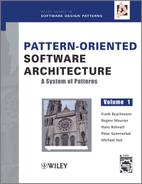Book Description
Pattern - Oriented Software Architecture A System of Patterns Frank Buschmann, Regine Meunier, Hans Rohnert, Peter Sommerlad, Michael Stal of Siemens AG, Germany Pattern-oriented software architecture is a new approach to software development. This book represents the progression and evolution of the pattern approach into a system of patterns capable of describing and documenting large-scale applications. A pattern system provides, on one level, a pool of proven solutions to many recurring design problems. On another it shows how to combine individual patterns into heterogeneous structures and as such it can be used to facilitate a constructive development of software systems. Uniquely, the patterns that are presented in this book span several levels of abstraction, from high-level architectural patterns and medium-level design patterns to low-level idioms. The intention of, and motivation for, this book is to support both novices and experts in software development. Novices will gain from the experience inherent in pattern descriptions and experts will hopefully make use of, add to, extend and modify patterns to tailor them to their own needs. None of the pattern descriptions are cast in stone and, just as they are borne from experience, it is expected that further use will feed in and refine individual patterns and produce an evolving system of patterns. Visit our Web Page http://www.wiley.com/compbooks/
Table of Contents
- Cover
- Half Title page
- Title page
- Copyright page
- Dedication
- About this Book
- Guide to the Reader
- Chapter 1: Patterns
- Chapter 2: Architectural Patterns
- Chapter 3: Design Patterns
- Chapter 4: Idioms
- Chapter 5: Design Patterns
- Chapter 6: Patterns and Software Architecture
- Chapter 7: The Pattern Community
- Chapter 8: Where Will Patterns Go?
- Notations
- Glossary
- References
- Index of Patterns
- Index
